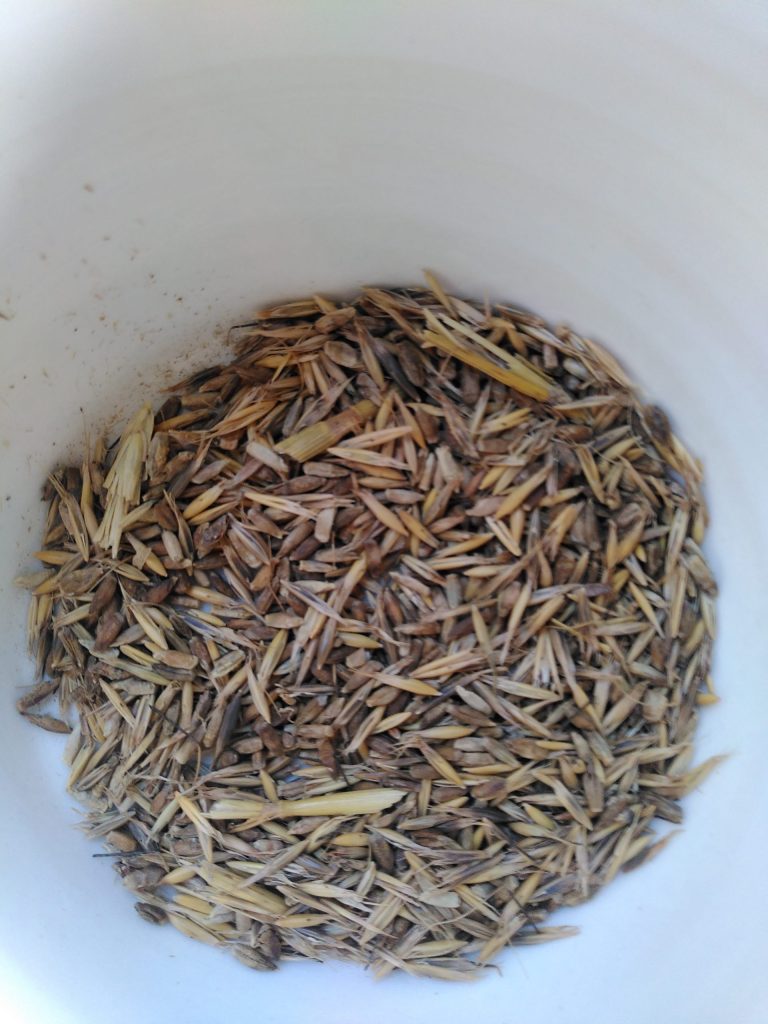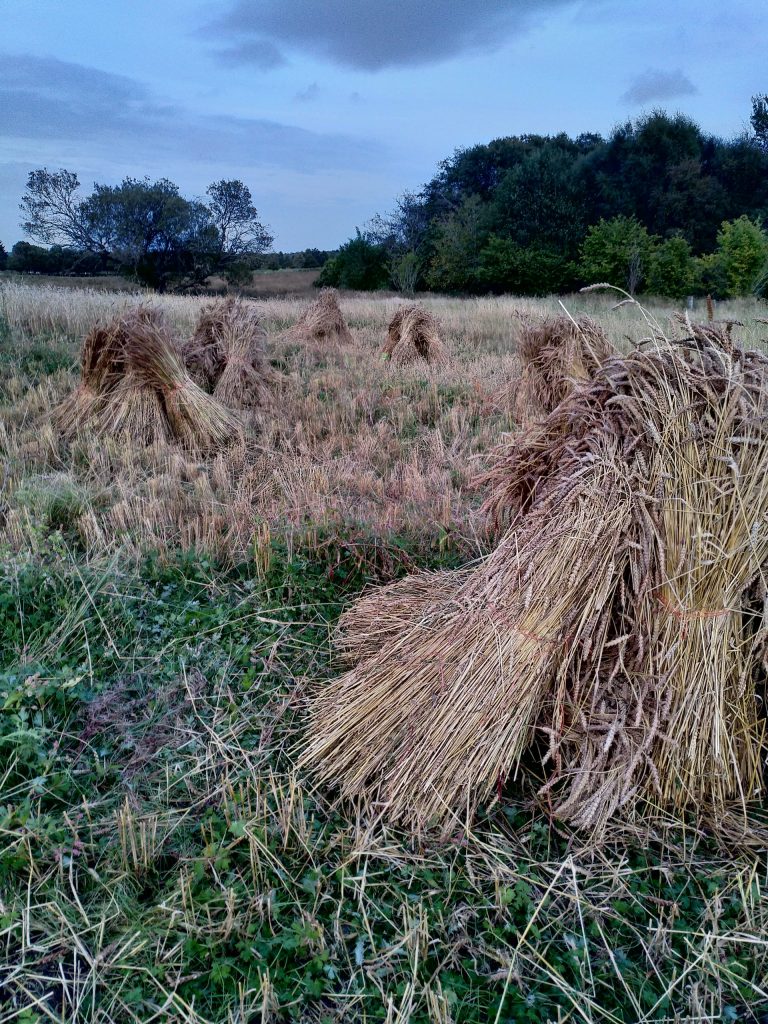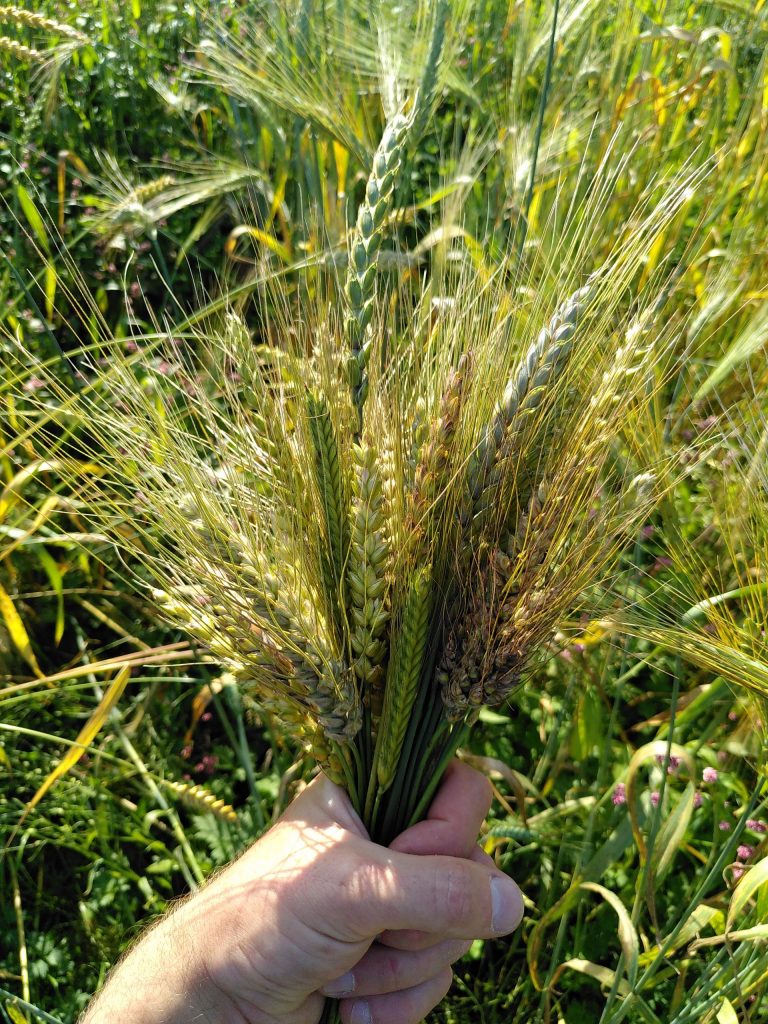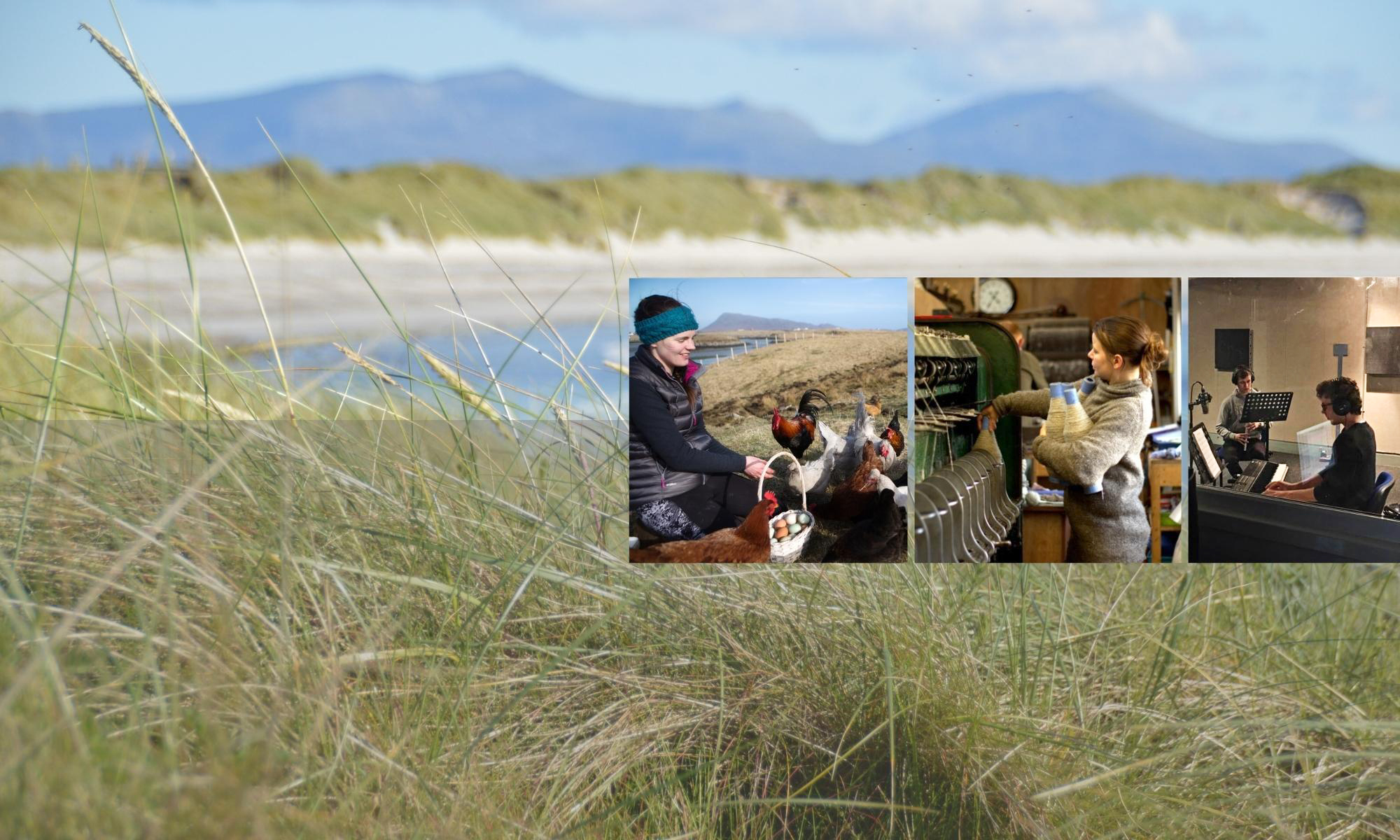Blogpost by Col Gordon, which appeared in The Learned Pig, 5Apr21.

“Open world begins with place, not with simple piety of place, but with knowledge (informed, sentient, intelligent) of place. Thoroughly known, every place is open. From the smallest rivulet, via a network of rivers, one arrives at the ocean. A little geology allows one to know that not all the stones on the local beach are necessarily of local origin, that glaciers may have brought them in from elsewhere. Likewise, from a layer of local rock one can move across nation and continents. An informed look at the sky will see mot only wind-driven cloud, but the tracks of migratory birds. To all of which must be added the movements of population and language.”
Kenneth White, The Wanderer and His Charts, 2004
“How many individuals, cultures, and histories are behind every seed sown? This vastness is important, for it is inseparable from the seeds. They must go together. They should all be on the seed packet, or handed to us by the last person to grow the plants who should know the names of these individuals, cultures, and histories. The people just by growing these plants are participating in all of this. They are doing a hell of a lot to keep the world alive. But do they know what they need to know to be actually keeping the seeds of culture alive along with the seeds that represent them?”
Martín Prechtel, The Unlikely Peace at Cuchumaquic, 2012
I’m a seed collector. Grains tend to be my thing. I see them as a vital component to envisioning a healthier farming system than the dominant one of industrialised monoculture we have today. Today fewer and fewer varieties of cereal are available to us, and those that are don’t tend to be fit for the healthier system we may wish to create. Over the past few years, I’ve written to a number of gene banks around the world requesting seed samples of different “accessions” of cereals. I’m then sent are little packets generally containing 5g of each different type of grain. I’ve received a great many seeds from places as varied as Georgia, France, Afghanistan, Ethiopia, Armenia, Switzerland, Azerbaijan, Iran, Germany, Morocco, Belgium, Tajikistan, and Spain.

Learning from seeds
These grains had all been deposited and maintained in centralised gene banks, often over a number of decades. In a sense, despite having originally come from very specific places, which you can often trace back to, they are often many generations removed from the parts of the world they developed and were originally from.
The purpose of me collecting all of these different seeds, is not to grow them out as a museum of the world’s grains with individual lines kept separate. What I’m doing with them is attempting to work out which seeds thrive on this farm, which happens to be in the Scottish Highlands. Far from everything grows and works well here, but a surprising amount shows great signs of potential. What I aim to do with this, is select all the seeds that look as though they have interesting characteristics and are able to express them well in this particular part of the world and then grow them all together in the field. Over a process of time these mixtures will develop into a more coherent “population”. Eventually these populations will be perfectly suited and adapted to this specific farm’s unique characteristics, challenges and conditions. Eventually this mixture of seed will become a “landrace” which can be defined as something that has “developed over time, through adaptation to its natural and cultural environment”. They will “belong” to this place.
Another angle of the seed work that I do is to track down and grow the last remaining landraces which have been grown, saved and passed on in an unbroken line for an unknown number of generations here in the north of Scotland. In today’s world, the fact that these still exist at all is very special. Seen by most modern farming standards, these landraces of small oats and bere barley, could be dismissed as agronomically unviable genetic throwbacks that can have no part to play in farming today. Keeping them going on marginal lands in the Western Hebridean Islands and the Northern archipelagos of Orkney and Shetland, is all fine and well, but these have no place in “modern” farming or agriculture. We can’t expect to “feed the world” with these. There may be some truth in this but, these were the crops that sustained the people who lived in this very marginal part of the world for hundreds if not thousands of years. Most of the terrain in the Highlands and Islands is not prime arable land, but yet these grains thrived in these conditions and supported high numbers of very active people. These are not inferior foods but forgotten foods, and we need to reimagine how to use them.
When I have these different seeds in my hands, I often think about all the history and culture that is embedded into them both from all different parts of the world. I don’t see these two different approaches to collecting grains as being in any way mutually exclusive. I am in no way held back from preserving and reimagining uses for the local landraces just because I’m also bringing in grains from all manners of different places and cultures. After these grains all get a chance to settle into being grown on this farm, they will hopefully complement each other to make a more beautiful, resilient and relevant arable system to the one we are currently working with or ones that have existed in the past.
Recently though, I’ve realised that I have missed a number of tricks with the seeds I collect from gene banks. In many ways, seeds are embodiments of the cultures from which they have come from. The two are intertwined. By losing track of or not giving due attention to where these seeds have come from and what meaning they have to these cultures, I’m guilty of colonial appropriation and an extractive attitude. These seeds belong to certain cultures and by being grown out by me in a different context, they have been decoupled and severed from their links to the customs and cultural traditions that go with them. These seeds have become displaced from these cultures and have been scattered across the world. If I wish to integrate them into my practice, they deserve to be repaired with some cultural context about where they have come from. If I wish to use them, I have a responsibility to attempt to understand, at least on a basic level, the stories and cultures that come with them.
“The historic role of capitalism itself is to destroy history, to sever any link with the past and to orientate all effort and imagination to what is about to occur.”
John Berger, Landscapes: John Berger on Art, 2016
Understanding our own histories
If we zoom out for a moment, we can see that, in many ways, we humans are facing very similar situations to these seeds. There is a dominant and ever encroaching capitalist monoculture which many believe is not giving us an option of a safe and healthy future. A great many of us today, like these genebank seeds, find ourselves scattered, displaced, cut off from our ancestral roots and without a sense of truly belonging to a place. If we do belong to an indigenous culture that, against all the odds, has managed to retain a sense of distinctiveness and autonomy, just like the landraces, they are looked upon by the rest of society as hangers-on from a by-gone day without any relevance to the modern world. Possibly we also feel that there is a tension and conflict between these two situations and, in a way, these can be seen as opposite ends of a spectrum.
Just as we need to create coherent new ways in which these seeds from all over the world belong to new places in a deeper way, we need to collectively learn how to feel sense of belonging to place in a deep way.
One common thread I see reoccurring through a great many indigenous cultures I’ve looked into is reverence for and veneration of ancestors. This is apparent in many different parts of the world and different cultures. Maybe it’s a case of seeing ourselves as a part within a continuum. We can hear values such as “borrowing the land from future generations”, sentiments which have an inherent idea of ‘sustainability’. But as well as that, knowing who your ancestors are and knowing their history give you a greater sense of who you are.
According to Amílcar Cabral, the great anti-colonialist, cultural autonomy and liberation is based on “the inalienable right of every people to have their own history; and the aim of national liberation is to regain this right (which has been) usurped by imperialism”. We need to understand our history. Our collective history and our own family histories. This is going to involve a lot of work. It’s going to be scary and daunting. Sometimes it may involve significant grief and/or shame. But we need to know our history and this needs to be an honest view of history, warts and all. In Scotland, we are prone to buying into a narrative of being the historical victim, editing out our very significant roles in various imperial and colonial projects. We are choosing to remember a half history. Scots-Jamaican councillor Graham Campbell refers to this as “organised forgetting“. Our historic past needs to be known to give us an idea of where we are and who we are in the historical present.
Many folks will find that various lines of their ancestry can be traced to specific cultures and places, some of which may be very different to where they are situated today and call home. This process may involve an investigation into these specific cultures and places. Beginning to get a fuller understanding of who we are and where we have come from can give you a sense of positioning and orientation to move through the world with. Start to learn about these places’ unique histories and cultures: their stories and songs, their festivals and celebrations, their foods and foodways, and the spiritualities and rituals traditions of these places. All these different things can begin to give you a grounding in where you have come from individually. If you find that much of your ancestry points to the place you find yourself still in, do exactly the same, start digging a little to uncover and understand what this particular place’s history and culture is.
“We can think of place-making as something that happens through movement: significance, memories and relationships are created by patterns of walking, approaching, branching away, visiting, gathering.”
Michael Given, Attending to place and time, 2020
Understanding “this place”
To feel that you “belong to a place” is to have a deep and thorough knowledge of that specific place. Starting to “belong” could be seen as being much less about belonging to an existing culture, but instead being deeply connected to a certain place through a thorough understanding of it: of that specific place’s terrains, weather patterns, flora, fauna, fungi, as well as an understanding of this place’s place name’s, stories and folklore, and histories from what has come before. It’s about knowledge of specifics. Specifics to that place. This knowledge needs to be accumulated, over time, through observation and interaction with that place, but can also be informed by knowing about what has come before in this place. There might well be a minority language that is still spoken in here, which, if learnt, can offer a lens through which to gain deeper and richer understandings of the human observations and interactions which have already taken place here. To start to belong to a certain place will involve gaining a thorough knowledge of and reverence for it.
Archaeologist Michael Given uses the term “conviviality” to describe an ongoing conversation and interactive, working relationship with a place’s natural rhythms, seasonal changes, ecological processes and the movement of other species through it. “Seasonality demands a close awareness of, response to, and negotiation with the changing attributes and affordances of plants, weather, soil, water, animals and of course, those other animals called humans. This attentiveness enables a recognition of interdependence.”
It’s important to say here, that the knowledge and learning required here is not just intellectual, but just as much sensory and bodily. It involves physically moving through spaces, smelling different seasons, feeling the cold, or the heat, or the dampness or the wind, tasting your way through it. Movement and seasonality are in fact key to gaining this understanding. As Given says:
“for humans, mobility is the key to navigating and negotiating these complex rhythms and patterns. It acts as a bridge between different areas, opportunities and meaningful places. It is mobility that enables the circulation of practice, social connection, meaning and interaction with the environment, thus generating families and communities with a sense of cohesion and meaning.”
To know and understand spaces we belong to, we must constantly move through them and interact with them. We must learn to understand their unique rhythms of how they change with the seasons, the tides, winds.
So where to begin? If coming at it from somewhat of a standing start this will seem daunting. Are there any practical, structured ways that you can begin to go about this? Luckily, an ever increasingly popular activity – foraging – is something that can offer ways to begin this process in a way that is both very practical and structured. It is also an activity that is accessible to anyone, anywhere. There are foraging groups emerging everywhere and a great deal of resources available specific to most places. In The Forager Handbook (2009), professional forager Miles Irving writes that “gathering wild food in our own locality creates a rich and ongoing relationship with the land. When we start digging around for this forgotten knowledge, we are getting into the ground of our heritage. Our ancestors knew the places where they lived: every inch of land, every kind of plant, every sign of life. They made use of everything. They were intimately involved with their surroundings, immersed in the ebb and flow of the seasons. Their attention was anchored to the here and now as they watched with anticipation the gradual emergence of shoots and stems, flowers and fruits, waiting patiently for the time to gather and make used of them. Signs indicating the presence of plants, animals, birds, and fish consumed their consciousness. With senses sharpened to the immediacy of instinct they discerned the presence of every animate or inanimate object. In doing so they were themselves powerfully present.”
Foraging offers a powerful and practical structure through which to practice this movement and attentiveness to place and through this begin to understand its own particular natural rhythms and seasonality. This understanding of place could be the first step needed to begin to belong to it.
“To restore any place, we must also begin to re-story it, to make it the lesson of our legends, festivals, and seasonal rites. Story is the way we encode deep-seated values within our culture. Ritual is the way we enact them. We must ritually plant the cottonwood and willow poles in winter in order to share the sounds of the vermillion flycatcher during the rites of spring. By replenishing the land with our stories, we let the wild voices around us guide the restoration we do. The stories will outlast us.”
Gary Paul Nabhan, Cultures of Habitat, 1997
Repurposing Ritual
Of course, awareness and understanding of seasonal rhythms is not something that is restricted to gathering wild foods. The farming calendar is made up of tasks that are performed at certain times of year and often happen on certain dates. There are set times of year when tasks are performed, which are in response to the natural opportunities and limitations of the seasonal changes. Planting cereals will happen at particular times of years either in the Autumn after harvest or in the Spring; Lambing and calving will, generally speaking, happen early in the year; the shearing or clipping of the sheep fleece will happen in the summer; livestock sales tend to be towards the end of the year once the growing season has fattened up the animals; pruning and planting of trees will happen early in the year before the sap starts rising up into the trees. The farming year is very much shaped by seasonality.
Historically in Highland Scotland, these seasonal shifts and their associated agricultural tasks were often marked by specific festivals, customs and rituals. The two most significant seasonal of these were Beltane (1st May) and Samhain (31st October). These were this region’s marker points to signify the beginning and the end of the growth season. As F. Marion McNeill writes in The Silver Bough: Vol. III (1961): “whilst Beltane celebrated the renewal of vegetation, Samhuinn solemnised its decay”. By Beltane, all the cereal should have been sown in the low lying and more fertile glens (in-bye) and the livestock would be herded up into the upland hills (out-bye) to spend the long, summer months up in the shielings or summer pastures. By Samhain all the crops should be harvested and the livestock would have returned back down the hills to spend the winter low in-bye.

The other two major festivals were Imbolc (1st February) and Lughnasa (1st August), which both were centred around the seasonality of milk and grains: Imbolc signified the beginning of the lambing and with it the year’s return of milk. Anecdotally I have also heard that Imbolc was the traditional date that the grain from the previous year’s harvest had finished “curing” and was ready for grinding. Lughnasa marked the beginning of the year’s grain harvest but also was the marker for when the sheep milk would begin to dry up for the year. All of these festivals would involve all manners of elaborate rituals and rites. For the most part these agricultural rituals are no longer celebrated.
To many modern people “ritual” is an uncomfortable and somewhat alien word. It’s not the type of thing we are accustomed to thinking or talking about, much less practicing. Even the mention of it can put us on edge and immediately bring to mind images from films like “The Wicker Man”. This needs to be kept in the back of our minds, but at the same time we need to recognise that even in modern, secular society rituals are things we still, often practice. This can be day to day things such as making the bed, drinking coffee or tea in the morning, laying the table and eating together, opening and shutting the curtains, etc. It can also be things we do on specific calendar dates. For instance, my own year might involve: guising (trick or treating) and bobbing for apples on Halloween; bonfires, fireworks and burning effigies on Guy Fawkes Night; hanging wreaths and decorating evergreen trees in the run up to Christmas; staying up late and seeing in the bells on Hogmanay; first footing on New Year’s Day; candlelit dinners on Valentine’s Day; eating pancakes on Shrove Tuesday; practical jokes on the morning of April Fool’s day; and painted and chocolate Eggs at Easter. Rituals are still being practiced and carried out and remain important to us, whether we think about them as rituals or not. These are all things that need to happen at specific times in a year to retain any semblance of meaning that might be left in them. If they stray from these dates, they make less sense to us.
But yet, despite still being observed in today’s modern, largely secular society, much of the meaning these rituals are supposed to hold is no longer there. Do many of us still know why we eat pancakes on Shrove Tuesday or hang wreaths around Christmas? Do many of us care? This loss of meaning should not go unnoticed, as without this sense of meaning these processes seem neutered. Do most of us really feel that burning an effigy of Guy Fawkes is necessary today? Probably not. But the process of this ritual is something that still draws us together to participate in. Interestingly, in the town of Lewes in the South East of England, this ritual has regained its potency, by updating the effigy from that of Guy Fawkes to a caricature of a leading political “villain” from that year. This simple change has made it an event that draws folks from all over the country to come take part in. It’s been re-given meaning.
Just like the ritual festivals of Beltane and Samhain in Highland society, in traditional societies across the world, we find similar ritual festivals built into their particular calendars, which reflect the seasonal and agricultural changes of these places. The timing of these seasonal changes are things that we have no real control over nor can be deviated from in any significant way.
On the other hand, the specific traditions, rituals, customs and festivals that are used to mark these seasonal points need not be set in stone at all. Whilst there may be existing cultural traditions and practices, these can be melded and meshed with traditions and customs from elsewhere or invented afresh. There is opportunity here to create new culture together in an inclusive way, informed and inspired by ancestral traditions of anywhere in the world, but made specific to this place.
In The Future of Ritual: Writings on Culture and Performance (1993), theatre writer Richard Schechner points out:
“human ritual, too, might be said to short-circuit thinking, providing ready-made answers to deal with crisis. Individual and collective anxieties are relieved by rituals whose qualities of repetition, rhythmicity, exaggeration, condensation, and simplification stimulate the brain into releasing endorphins directly into the bloodstream yielding ritual’s second benefit, a relief from pain, a surfeit of pleasure.”
The possibilities implied here are exciting. As mentioned earlier, in uncovering our own personal and collective histories, we are going to be faced with dealing a potentially overwhelming amount of trauma. Some of us will need to have ways to deal with ancestral grief; some of us will need to have ways to deal with ancestral shame; many of us will have to deal with both.
These traumas are incredibly complex and deep and we need ways to process them. In so many ways, we need to work out how to do this collectively, as well as individually, so we can heal, reconcile and understand each other. Perhaps creating new rituals could be one way to do this. The poet Kenneth White writes that the great work needed of us at this time “is to integrate aspects of many cultures into a new coherence”. Ritual could be a means through which to imagine new cultures, to understand belonging and to discover shared values. This can happen both individually and collectively as communities, dwelling in these specific places.
“By the time a century or two of exploitation has passed there comes about a veritable emaciation of the stock of national culture. It becomes a set of automatic habits, some traditions of dress and a few broken-down institutions. Little movement can be discerned in such remnants of culture; there is no real creativity and no overflowing life.”
Frantz Fanon, The Wretched of the Earth, 1961
Cultural Coherence
At the 2021 Oxford Real Farming Conference, seed keeper Rowen White made a compelling case that “we are in a crisis of culture”. Knowing our own history and culture, according to Amílcar Cabral, does not mean that these have to be static or fixed. Far from it. “Culture, like history, is necessarily an expanding and developing phenomenon”. Cultures are constantly morphing and shifting. In a healthy culture elements other outside cultures are adopted whilst other are ignored, just as elements of their own cultures are retained whilst others are dropped.

At this point it might be useful to go back to the seeds which I started with. “Find your people’s seeds,” writes Martín Prechtel. “Lacking those, find seeds of the edible plants you love the most. Then find their stories. Then go further; find their scientifically explained origins, then find their real mythological origins.” Just like these seeds, not everything we bring to the field is necessarily going to work well. Over time, with a lot of trial and error, we will find that some seeds work really well in this place where as others are not as well suited and disappear.
But with those that work well, we need to go back and find out more about them. These seeds will grow together and mix together; learn how to navigate the specific characteristics of the fields together; and they will begin to thrive together. Over time these dispersed seeds will become what we now call a “landrace”. These fields will not only be filled with beautiful, diverse seeds of all tonalities, shapes and colours, but also filled with beautiful meanings, stories and histories, somehow brought together in a coherent, unified way.
We need to find our own stories, we as humans need to learn to understand this place we find ourselves situated in, and we need to work out how to bring our stories together in a way that works in this specific place. As Rowen White says, “we need to be culture makers”. Quietly, these tasks of belonging and culture making may well be some of the most pressing and urgent that we are faced with at this moment.

